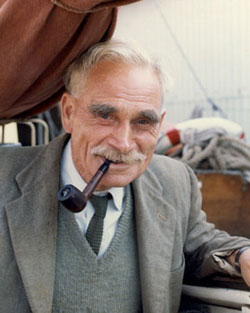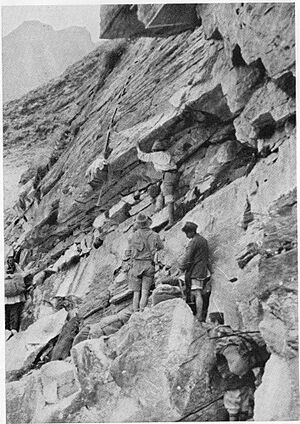Bill Tilman facts for kids
Quick facts for kids
Bill Tilman
|
|
|---|---|

Bill Tilman by Sandy Lee
|
|
| Born | 14 February 1898 |
| Died | 1977 (aged 79) South Atlantic Ocean
|
| Occupation | Mountaineer, Explorer |
Bill Tilman (born Harold William Tilman, 14 February 1898 – 1977) was a brave English mountaineer and explorer. He was famous for his amazing climbs in the Himalayas and his long sailing trips across oceans. He was also a decorated soldier, earning several awards for his courage.
Contents
Early Life and African Adventures
Bill Tilman was born in 1898 in Wallasey, England. His father was a successful sugar merchant. Bill went to Berkhamsted Boys school. When he was 18, he joined the Royal Field Artillery and fought in the First World War. He showed great bravery and was awarded the Military Cross twice.
After the war, Bill moved to Kenya, East Africa, where he grew coffee. There, he met Eric Shipton, another adventurous spirit. Together, they became a famous climbing team. They climbed Mount Kenya in 1929, and later conquered Mount Kilimanjaro and the Ruwenzori (also known as the "Mountains of the Moon"). When it was time to leave Africa, Bill didn't just fly home. He rode his bicycle all the way across the continent to the West Coast, then sailed to England!
Courage in World War II
When the Second World War began, Bill Tilman volunteered to serve again. He helped cover the retreat of soldiers during the Battle of France, which led to the famous Dunkirk evacuation. Later, he served in North Africa, Iraq, and Iran.
In 1943, Bill was chosen for a special mission. He parachuted behind enemy lines into Albania. There, he fought alongside Albanian and Italian freedom fighters. For his brave actions, he received the Distinguished Service Order. He even helped save the city of Belluno from being destroyed, and the city gave him its keys as a thank you.
Conquering Himalayan Peaks
Bill Tilman was a key figure in the Mount Everest expeditions of the 1930s. He joined the 1935 Reconnaissance Expedition. In 1938, he led an expedition and reached an incredible height of 27,200 feet (about 8,290 meters) without using extra oxygen.
One of his greatest achievements was exploring the Nanda Devi area. In 1934, he and Eric Shipton were the first to enter the hidden "Nanda Devi Sanctuary." Then, in 1936, Bill led an expedition that made the first successful climb of Nanda Devi. This mountain is 7,816 meters (25,643 feet) high. For many years, it was the highest mountain ever climbed by humans!
Bill described reaching the summit:
-
- It was hard to believe we were standing on top of the same peak we had seen from far away, which looked so remote. It felt amazing to know we were higher than any other peak for a hundred miles around. We even shook hands to celebrate!
Bill continued his explorations. In 1939, he tried to climb in the unexplored Assam Himalaya. His team faced many challenges, including Malaria. In 1947, he attempted Rakaposhi and later joined Eric Shipton for a climb on Muztagh Ata. He also explored parts of Nepal, climbing Paldor (5,896 meters) and discovering a mountain pass named after him. In 1952, he received the Royal Geographical Society's Founder's Gold Medal for his amazing explorations.
Sailing to New Adventures
After his military service, Bill Tilman found a new passion: deep-sea sailing. In 1954, he bought a boat called Mischief, which was a type of boat called a Bristol Channel pilot cutter. He then sailed to the icy waters of the Arctic and Antarctic. He was always looking for new, uncharted mountains to climb in these remote places.
He continued his voyages on other boats, Sea Breeze and Baroque. On his last voyage in 1977, when he was 79 years old, Bill joined a crew sailing to the South Atlantic. They were going to climb Smith Island. Sadly, his ship, En Avant, disappeared without a trace on its way to the Falkland Islands. It is believed the ship sank with everyone on board.
Bill Tilman was a true adventurer, always seeking new challenges whether on the highest mountains or the wildest seas.
Key Expeditions and Voyages
Here are some of Bill Tilman's notable adventures:
- 1929: Began rock climbing in England's Lake District.
- 1930: Climbed Mount Kilimanjaro and Mount Kenya with Eric Shipton.
- 1932: Ascended peaks in the Ruwenzori Range.
- 1934: First to enter the Nanda Devi Sanctuary with Eric Shipton.
- 1935: Joined the Mount Everest reconnaissance expedition.
- 1936: Led the first successful climb of Nanda Devi.
- 1938: Led another Mount Everest expedition, reaching high altitudes.
- 1939: Explored the remote Assam Himalaya.
- 1947: Attempted Rakaposhi and Muztagh Ata.
- 1949: Explored Nepal and climbed Paldor.
- 1955: First voyage in his boat Mischief, crossing the Southern Patagonian Ice Field.
- 1957: Sailed around the entire continent of Africa.
- 1961-1976: Made many voyages to Greenland, Baffin Island, Jan Mayen, and Spitzbergen, often looking for new mountains to climb.
- 1977: Last voyage to the South Atlantic, where his ship disappeared.


